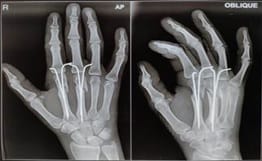Retrospective analysis of Intramedullary K-Wire fixation of Metacarpal Fractures
Kumar Kirar S.1, Upadhyay S.2*, Singh S.3, Varshney A.4
DOI: https://doi.org/10.17511/ijoso.2021.i02.05
1 Sunil Kumar Kirar, Senior Resident, Department of Orthopaedics, ABV Government Medical College, Vidisha, Madhya Pradesh, India.
2* Sanjay Upadhyay, Assistant Professor, Department of Orthopaedics, ABV Government Medical College, Vidisha, Madhya Pradesh, India.
3 Sanat Singh, Associate Professor, Department of Orthopaedics, ABV Government Medical College, Vidisha, Madhya Pradesh, India.
4 Atul Varshney, Professor & HOD, Department of Orthopaedics, ABV Government Medical College, Vidisha, Madhya Prdaesh, India.
Introduction: The majority of fractures of the metacarpal bones occur at a young age.Most of the times these metacarpal fractures can be treated conservatively in a POP slab(cock up slab) producing good functional results.Surgery was indicated in patients with palmar dislocation of >30° and shortening of >5 mm.Our study aimed to evaluate the clinical results of all metacarpal fractures treated surgically by intramedullary Kirschner-wire fixation presented in our hospital.Materials and Methods: It was a retrospective study in which we included 50 patients with metacarpal fractures(both open andclosed) that came in our hospital, treated surgically by closed reduction and were fixed with two intramedullary k-wires. Result: K-wires were removed after 4 weeks postoperatively,under local anaesthesia in the OPD. Metacarpal joint functions (flexion, extension, rotation) were clinically followed up in all patients, on the median periodof6 months (3 months to 9 months). In our study, we found in all patients,flexion and extension were normal on both sides.Conclusion: Closed reduction and intramedullary k-wire fixation of metacarpal bone fractures produce good functional results in the longterm. We found a very low rate of complication and thus recommendthis surgical method for the stabilization of all these types of fractures.
Keywords: Metacarpal, Flexion, Extension, Rotation, K-wire
| Corresponding Author | How to Cite this Article | To Browse |
|---|---|---|
| , Assistant Professor, Department of Orthopaedics, ABV Government Medical College, Vidisha, Madhya Pradesh, India. Email: |
Kirar SK, Upadhyay S, Singh S, Varshney A. Retrospective analysis of Intramedullary K-Wire fixation of Metacarpal Fractures. Surgical Rev Int J Surg Trauma Orthoped. 2021;7(2):22-27. Available From https://surgical.medresearch.in/index.php/ijoso/article/view/228 |


 ©
© 